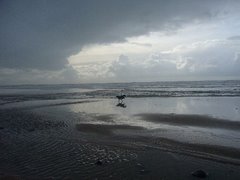Monday 31 October 2011
Baby Ozzy?
This painting by Sir Edwin Henry Landseer, RA (7 March 1802 – 1 October 1873) is called Doubtful Crumbs. Landseer was an English painter, well known for his paintings of animals—particularly horses, dogs and stags. The best known of Landseer's works, however, are sculptures: the lions in Trafalgar Square. The puppy looks like a baby Ozzy.
Friday 28 October 2011
Slumdogs
Tuesday 25 October 2011
Cool new editor
Jill Abramson is the newly appointed executive editor of the New York Times, a powerful journalist and investigative reporter both revered and feared by her colleagues and her peers. She is the first woman ever to run the Times.
She has received a publicity blitz in the last few weeks with a profile in the latest issue of The New Yorker, an interview on CBS News and the release of “Puppy Diaries: Raising a Dog Named Scout”, her new book based on a popular online column which she wrote for The Times from July 2009 to May 2010. It is her account of the first year with a beautiful but demanding golden retriever, called Scout. Abramson wrote the book after two major events in her life, the death of her dog Buddy, a West Highland Terrier and a near-fatal accident when she was run over by a lorry near Times Square . The latter incident required months of rehabilitation. Also, although she has a high-powered career, she confesses the emptiness after the leaving home of her grown children. All goods reason to acquire a puppy.
Wednesday 19 October 2011
Otter hound
Rosa Bonheur (1822-1899) painted this picture of an otter hound which can be seen at the Wallace Collection.
By family accounts, she had been an unruly child and had a difficult time learning to read. To remedy this her mother taught her to read and write by having her select and draw an animal for each letter of the alphabet. To this practice in the company of her doting mother she attributed her love of drawing animals.
Her most famous work is the monumental (8 feet high and 16 feet wide) The Horse Fair which she painted in 1849 and which was purchased by the American millionaire Cornelius Vanderbilt and which now hangs in the Metropolitan Museum in New York.
Oddly enough she was more popular in England than in France
An early Bohemian and feminist, Bonheur defied female convention of the day by wearing men’s clothing and smoking cigarettes. On her wearing of trousers, she said at the time that her choice of attire was simply practical as it facilitated her work with animals: "I was forced to recognize that the clothing of my sex was a constant bother. That is why I decided to solicit the authorization to wear men's clothing from the prefect of police. But the suit I wear is my work attire, and nothing else. The epithets of imbeciles have never bothered me...."
 |
| The Horse Fair |
Saturday 15 October 2011
Interaction with humans
A study by Monique Udell and her team, from the
Udell and her team carried out two experiments comparing the performance of pet domestic dogs, shelter dogs and wolves by giving the animals the opportunity to beg for food, from either an attentive person or from a person unable to see the animal.
They wanted to know whether the rearing and living environment of the animal (shelter or human home), or the species itself (dog or wolf), had the greater impact on the animal's performance.
They showed, for the first time that wolves, like domestic dogs, are capable of begging successfully for food by approaching the attentive human.
This demonstrates that both dogs and wolves have the capacity to behave, observe and respond to a human's attention.
In addition, both wolves and pet dogs were able to rapidly improve their performance with practice.
The authors also found that dogs were not sensitive to all visual cues of a human's attention in the same way.
In particular, dogs from a home environment rather than a shelter were more sensitive to stimuli predicting attentive humans. Those dogs with less regular exposure to humans did not perform and responded as well.
Thursday 13 October 2011
Facelift
At the age of two Boycie suffered from excess skin folds, which left him without sight.
Boyce, who is being cared for by the Dogs Trust, in
Tuesday 4 October 2011
Subscribe to:
Posts (Atom)





















